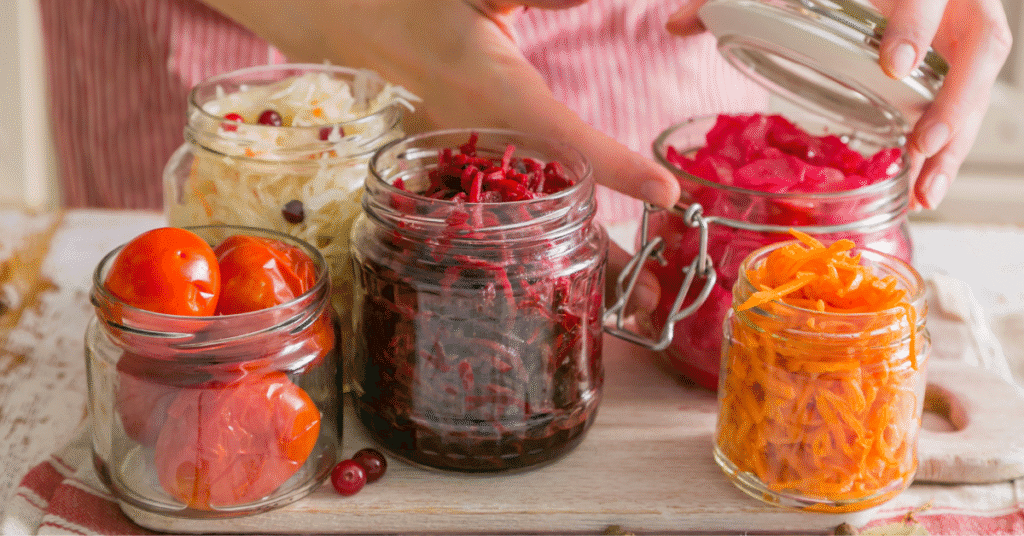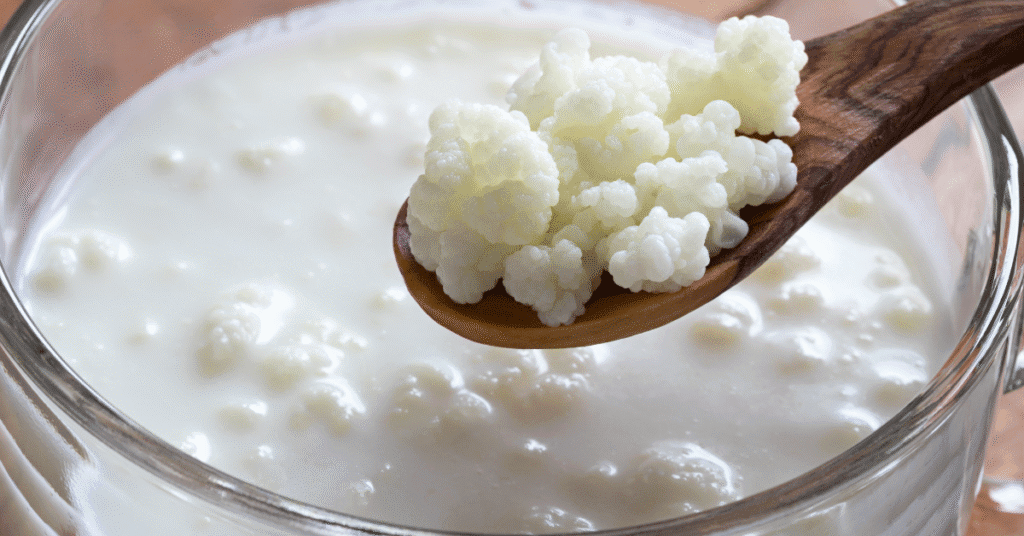Fermented foods have been consumed for thousands of years. Ancient diets emphasized fermented foods such as cultured vegetables, kimchi, and tempeh, a traditional soy product originating from Indonesia. And with good reason! These foods were a critical component of overall health, providing a rich source of lactic acid-producing bacteria that occur naturally on raw vegetables – an essential piece in the complex puzzle that is your gut microbiota.
Unfortunately, most fermented foods today are high in sugar and low in beneficial bacteria. However, consuming fermented foods, especially high-quality, traditionally fermented pickles and fermented dairy, is important in your gut-friendly, ancestral diet.
Incorporating a variety of fermented foods will ensure that multiple strains of beneficial bacteria are introduced into your gut, including bacteria necessary for continued production of biogenic amines.
Fermented foods are rich in probiotics. Consuming probiotics can help to diversify the gut, filling the lower intestine with beneficial bacteria and aiding in digestion and the absorption of vitamins and minerals. Gut flora are thought by many to be the last uncharted organ of the human body. Among the most abundant of such gut flora is Bifidobacteria, a friendly bacteria that can be found in some fermented dairy products. It performs many vital functions in the human body.
The Science Behind Fermentation: How It Benefits Your Gut
You might remember learning about enzymes and how they help break down food when you were in school. In fact, you may even have participated in an experiment in which you chewed a saltine cracker for a really long time and noticed that it tasted sweet. This happened because an enzyme found in saliva changed the carbohydrates in the cracker into smaller sugar molecules called glucose. Fermentation is essentially the action of enzymes doing their job of breaking down carbohydrates, proteins, and fats, but in this process, bacteria, yeast, and molds are at work rather than human or animal enzymes.
Why is this good? Because many bacteria are good for us, especially those that are essential for maintaining a healthy gut.
By definition, fermentation is a metabolic process in which an organism converts a carbohydrate, such as starch or a sugar, into an alcohol or an acid. This process occurs when viable microorganisms are present and at work. Microorganisms can ferment sugars to produce alcohol, producing byproducts such as acetic acid or lactic acid. These are the compounds that occur naturally in fermented foods. Beer and wine, for example, are fermented and turn into alcoholic beverages due to the presence of yeast. An example of lactic acid bacteria is lactobacillus, which is found in fermented foods such as yogurt, kefir, kimchi, and pickles. Fermentation can change the flavor or aroma of a food or drink because the microorganisms produce different enzymes, acids, and compounds that are responsible for taste, color, and texture changes. Some of these compounds have been shown to have numerous health benefits.

The Role of Probiotics in Fermented Foods: Supporting a Healthy Microbiome
In fermented foods, the process converts whole, raw foods into highly nutritious, preserved products. This natural transformation is accomplished by a diverse group of beneficial bacteria, yeast, and molds. Without the potentially dangerous byproducts of industrial food production, the benefits of naturally fermented foods come from fermented raw foods and “friendly” strains of microorganisms. Probiotics are promoted as essential for optimal digestion and immune system health, which makes consuming naturally cultured foods—and making organic cultured foods—particularly beneficial. Most microorganisms are killed or inactivated during industrialized foods’ cooking and pasteurization process. While this is problematic for creating safe, long-lasting packaged foods, consuming sterile food divorced from the beneficial bacteria we co-evolved with is, ironically, unhealthy. Probiotic bacteria support the human microbiome and are key to a healthy digestive system. Even many yogurts mass-produced in dairy factories are pasteurized, and to bio-ferment a product in the traditional style at home, pasteurized milk is less than optimal. This also applies to alcohol. Aged beer and wine have high alcohol content and are void of probiotics, as during their aging process, the probiotics co-mingle with flavors of fruit and herbs. Fermented food was key to our microbiota diversity and contributed to homeostasis and harmony between our body and the trillions of bacterial cells that inhabit our gut. We need to revisit traditional fermentation methods and use raw, organic, whole foods whenever possible to improve our microbial diversity. If more people eat these traditionally processed foods, they will be restoring traditional modes of sustainable production known to humanity for thousands of years.
Common Fermented Foods and Their Probiotic Content
Given the increase in popularity of fermented foods, it is important to highlight some of the most important and most often consumed in the world.
Fermented foods are made or transformed by the action of microorganisms. These foods may have a longer shelf life, better flavor, and more beneficial properties that improve the health of their consumers. The fermentation of solutions can convert sugars into alcohol and carbon dioxide. At the same time, that of makings or animal products can lead to the development of lactic, acetic, or propionic acid bacteria. There are different types of fermented foods. According to the microorganism or microorganisms involved, you can have alcoholic beverages, dairy products, cocoa, vegetables, fruits, cereals, soybeans, meats, and fish. These are not all fermentable products; exceptions have been reported.
Although estimates of lactic acid bacteria and bifidobacteria by meters show the presence of probiotic species in fewer amounts in fermented foods, these have been shown to be beneficial to humans. The present review shows fermented foods prepared through traditional or home techniques being an important source of mapping probiotic species. Due to their ability to transform raw materials and generate flavors, these foods are recognized by society and have high consumption, especially by Asians. The selection of plants is observed in places with climatic and physiographic conditions that favor their development. Traditional preparations are used, recognition of sensory indicators, and the development of indigenous microorganisms. These foods are considered natural fermentations because they stimulate the selection and growth of microorganisms and are free of additives and the external addition of microorganisms. Similarly, natural fermentations are rich in probiotic species. To understand how these processes occur, we performed a scientific review.
Yogurt, Kimchi, Kombucha, and More:
Countless varieties of probiotic-rich, gut-supportive foods are available. Try kombucha, kefir, and kvass, or munch on kimchi, pickles, or sauerkraut. Enjoy Greek yogurt or other naturally fermented yogurts. Some cheeses are also traditionally fermented along with beneficial bacteria that help to populate the microbiota. Dark chocolate contains probiotics, too. The only problem is that the vast majority of chocolate products sold are loaded with sugar, and sugar actually fuels the overgrowth of harmful bacteria. Make sure your chocolate contains at least 70 percent raw cacao to support beneficial bacteria in your gut. And my all-time favorite? Tempeh, both for the flavor and the benefits for the gut.
Pickles and sauerkraut are common sources of probiotics among the many fermented foods available. But don’t reach for those on the grocery store shelf, since they are generally made with vinegar and are therefore not fermented. Make your own or look for “raw” versions in the refrigerated section of a reputable health food store. You can also try these tasty foods with sour Italian olives, dill pickles, or sauerkraut – chopped red cabbage with a little sea salt and caraway seeds makes a great topping for dishes or an addition to the side of a meal. Ferment it for flavor or not. Don’t want to drink something fermented? Eat some of these foods along with every meal instead.
Incorporating Fermented Foods into Your Diet
In short, not all fermented foods contain live bacteria. Commercial pasteurization kills the bacteria. Conversely, not all foods labeled “fermented” are true health-giving foods that we learned from traditional cultures. Not all fermentation processes kill pathogenic bacteria. For instance, botulism has been linked to home-fermented pickles and sauerkraut because the pH was not low enough to kill endospores. Commercial products undergo strict regulation to prevent the presence of live pathogenic bacteria. It is strong advice to purchase reputable products, or if fermenting at home, follow a researched and tested recipe.
In addition, eating vitamin C-rich foods is important while taking probiotics. New strains may be introduced after an intestinal reparative therapy as a continued dietary practice. Indeed, fermented foods can be considered probiotics when they are not commercially bought and contain live bacteria. However, some fermented foods may not necessarily have documented probiotic properties. Strains may not be able to survive commercial processing that ferments the food. As a result, not all fermented foods contain live probiotics beneficial for health.
Tips for Adding Probiotic-Rich Foods to Meals:

Incorporating probiotics into the diet can be done with a few simple kitchen changes. The following are key ways to include these beneficial fermented foods in your daily fare.
- Yogurt: Consider yogurt as a breakfast staple served with freshly ground flaxseed for extra benefit. Stir plain yogurt into cold soups, stews, or pasta recipes. For those who are not keen on the taste of yogurt, add stevia or your favorite fruit to the homemade version and serve with breakfast. Make a creamy dessert by adding yogurt as the filling in a fresh fruit crumble. Try creamy yogurt as a complement to spicy Indian dishes. Be sure to consume yogurt soon after purchase and be diligent with storage time. It may seem contrary to safe food storage guidelines, but the best results with yogurt are found within the shelf life of recommended storage.
- Kefir: Many babies over the millennia were weaned with kefir; start your day with the drink in a smoothie. Grill fruits such as peaches or fresh apricots and afterwards add some kefir as a creamy finish. Kefir can be poured over hot oats for a creamy start to the morning. This drink makes an easy quick bread to accompany meals. Use it in place of milk in yeast bread and bake as desired.
- Fermented vegetables: Fermented vegetables are gaining popularity and with good reason. Known as a tonic alkalinizing drink, kvass offers something different in the world of fermented drinks. It can be made from stale bread or beets. The variety in using kvass is only as limited as your imagination or the quantity of vegetables on hand. Brine and fermented fructose are essential for your digestive tract to break down meats. Try taking a sip of juice before or during your next meal. Think of cabbage as the start of making sauerkraut, which offers vitamins B and C as well as healthy enzymes.
- Kombucha: The name of kombucha originates from the SCOBY from which the beverage is made. It is probiotic-rich and the flavor is effervescent. The level of effervescence increases with the period of fermentation. Kombucha can be consumed as a concentrated shot before meals. For a unique flavor of the drink that can be enjoyed over time, pour a thick glass of kombucha over ice and top with either fresh or dried fruit.

